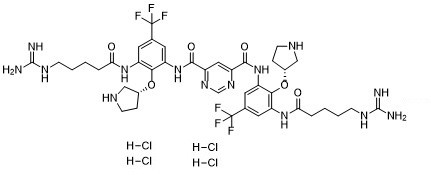Brilacidin tetrahydrochloride (PMX-30063; PMX 30063) is a novel and potent arylamide foldamer that can mimic the amphiphilic properties of antimicrobial peptides. Asa broad-spectrum antibiotic,Brilacidin shows a broad-spectrum antibiotic activity against Gram+ and Gram- bacteria.Brilacidin has low cytotoxicity against mammalian cells selectively targeting bacteria, directly and rapidly disrupting their membranes, resulting in the bacteria's death. Due to this unique mechanism of action (mimicking the host's natural immune response, proven to be successful in fighting off infections over millions of years of evolution), bacterial antibiotic resistance is less likely to develop.
Physicochemical Properties
| Molecular Formula | C40H54CL4F6N14O6 |
| Molecular Weight | 1082.7494 |
| Exact Mass | 1080.3 |
| Elemental Analysis | C, 44.37; H, 5.03; Cl, 13.10; F, 10.53; N, 18.11; O, 8.87 |
| CAS # | 1224095-99-1 |
| Related CAS # | Brilacidin;1224095-98-0 |
| PubChem CID | 45275360 |
| Appearance | Off-white to light yellow solid powder |
| LogP | 11.687 |
| Hydrogen Bond Donor Count | 14 |
| Hydrogen Bond Acceptor Count | 18 |
| Rotatable Bond Count | 20 |
| Heavy Atom Count | 70 |
| Complexity | 1560 |
| Defined Atom Stereocenter Count | 2 |
| SMILES | Cl[H].Cl[H].Cl[H].Cl[H].FC(C1C([H])=C(C(=C(C=1[H])N([H])C(C([H])([H])C([H])([H])C([H])([H])C([H])([H])/N=C(\N([H])[H])/N([H])[H])=O)O[C@@]1([H])C([H])([H])N([H])C([H])([H])C1([H])[H])N([H])C(C1=C([H])C(C(N([H])C2=C([H])C(C(F)(F)F)=C([H])C(=C2O[C@@]2([H])C([H])([H])N([H])C([H])([H])C2([H])[H])N([H])C(C([H])([H])C([H])([H])C([H])([H])C([H])([H])/N=C(\N([H])[H])/N([H])[H])=O)=O)=NC([H])=N1)=O)(F)F |
| InChi Key | QTHBCQCKYVOFDR-PIJQHSLXSA-N |
| InChi Code | InChI=1S/C40H50F6N14O6.4ClH/c41-39(42,43)21-13-25(57-31(61)5-1-3-9-53-37(47)48)33(65-23-7-11-51-18-23)27(15-21)59-35(63)29-17-30(56-20-55-29)36(64)60-28-16-22(40(44,45)46)14-26(34(28)66-24-8-12-52-19-24)58-32(62)6-2-4-10-54-38(49)50;;;;/h13-17,20,23-24,51-52H,1-12,18-19H2,(H,57,61)(H,58,62)(H,59,63)(H,60,64)(H4,47,48,53)(H4,49,50,54);4*1H/t23-,24-;;;;/m1..../s1 |
| Chemical Name | N4,N6-bis(3-(5-guanidinopentanamido)-2-(((R)-pyrrolidin-3-yl)oxy)-5-(trifluoromethyl)phenyl)pyrimidine-4,6-dicarboxamide tetrahydrochloride |
| Synonyms | PMX30063; PMX-30063; PMX 30063; Brilacidin; Brilacidin HCl; Brilacidin tetrahydrochloride; |
| HS Tariff Code | 2934.99.9001 |
| Storage |
Powder-20°C 3 years 4°C 2 years In solvent -80°C 6 months -20°C 1 month Note: Please store this product in a sealed and protected environment, avoid exposure to moisture. |
| Shipping Condition | Room temperature (This product is stable at ambient temperature for a few days during ordinary shipping and time spent in Customs) |
Biological Activity
| ln Vitro | Among the bacterial species, Staphylococcus aureus (SA) and Staphylococcus epidermidis (SE) have the lowest minimum inhibitory concentrations. Brilacidin's MIC90s for Serratia marcescens (SM), Moraxella (MS), Haemophilus influenza (HI), Pseudomonas aeruginosa (PA), Streptococcus pneumonia (SP), and Streptococcus viridians (SV) are 128-fold higher than those of SA and SE, respectively, at 4, 32, 256, 32, 16, and 16. In vitro, brilacidin possesses Gram-positive activity. Topical application of brilacidin 0.5% causes minimal irritation. When the corneal epithelium is removed from a methicillin-resistant S. aureus (MRSA) keratitis model, brilacidin 0.5% proved to be just as effective as vancomycin (VAN). Brilacidin mainly depolarizes the bacterial cell membrane in order to affect it. Compared to Gram-negative bacteria, brinalacidin is more effective against Gram-positive bacteria (apart from SV)[2]. |
| ln Vivo | In the NZW rabbit ocular toxicity model, brinalacidin exhibits dose-dependent ocular toxicity following seven topical instillations (every 30 minutes for three hours). Based on their Maximum mean total scores (MMTS) values, Brilacidin 1% is found to be Mildly Irritating (23.0), Brilacidin 0.5% (6.5), and Brilacidin 0.25% (4.0) to be Minimally Irritating, while Brilacidin 0.1% (2.0), TBS (1.0), and 0.01% Brilacidin (0.5) are found to be Practically Nonirritating and Nonirritating, respectively[2]. |
| References |
[1]. Comparative Mechanistic Studies of Brilacidin, Daptomycin, and the Antimicrobial Peptide LL16. Antimicrob Agents Chemother. 2014 Sep;58(9):5136-45. [2]. An Independent Evaluation of a Novel Peptide Mimetic, Brilacidin (PMX30063), for Ocular Anti-infective. J Ocul Pharmacol Ther. Jan-Feb 2016;32(1):23-7. |
Solubility Data
| Solubility (In Vitro) |
DMSO : ~83.33 mg/mL (~76.96 mM ) Methanol : ~10 mg/mL (~9.24 mM ) |
| Solubility (In Vivo) |
Solubility in Formulation 1: ≥ 6.25 mg/mL (5.77 mM) (saturation unknown) in 10% DMSO + 40% PEG300 + 5% Tween80 + 45% Saline (add these co-solvents sequentially from left to right, and one by one), clear solution. For example, if 1 mL of working solution is to be prepared, you can add 100 μL of 62.5 mg/mL clear DMSO stock solution to 400 μL PEG300 and mix evenly; then add 50 μL Tween-80 to the above solution and mix evenly; then add 450 μL normal saline to adjust the volume to 1 mL. Preparation of saline: Dissolve 0.9 g of sodium chloride in 100 mL ddH₂ O to obtain a clear solution. Solubility in Formulation 2: ≥ 6.25 mg/mL (5.77 mM) (saturation unknown) in 10% DMSO + 90% (20% SBE-β-CD in Saline) (add these co-solvents sequentially from left to right, and one by one), clear solution. For example, if 1 mL of working solution is to be prepared, you can add 100 μL of 62.5 mg/mL clear DMSO stock solution to 900 μL of 20% SBE-β-CD physiological saline solution and mix evenly. Preparation of 20% SBE-β-CD in Saline (4°C,1 week): Dissolve 2 g SBE-β-CD in 10 mL saline to obtain a clear solution. Solubility in Formulation 3: ≥ 6.25 mg/mL (5.77 mM) (saturation unknown) in 10% DMSO + 90% Corn Oil (add these co-solvents sequentially from left to right, and one by one), clear solution. For example, if 1 mL of working solution is to be prepared, you can add 100 μL of 62.5 mg/mL clear DMSO stock solution to 900 μL corn oil and mix evenly. Solubility in Formulation 4: 10% DMSO+40% PEG300+5% Tween-80+45% Saline: ≥ 6.25 mg/mL (5.77 mM) (Please use freshly prepared in vivo formulations for optimal results.) |
| Preparing Stock Solutions | 1 mg | 5 mg | 10 mg | |
| 1 mM | 0.9236 mL | 4.6179 mL | 9.2357 mL | |
| 5 mM | 0.1847 mL | 0.9236 mL | 1.8471 mL | |
| 10 mM | 0.0924 mL | 0.4618 mL | 0.9236 mL |
